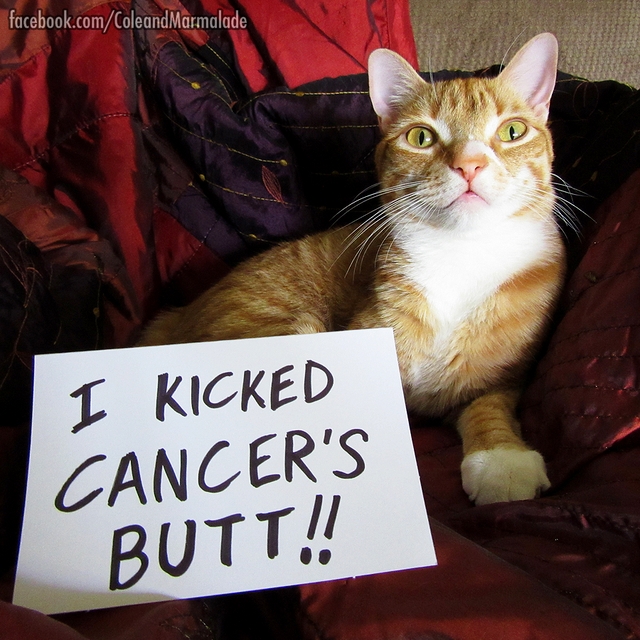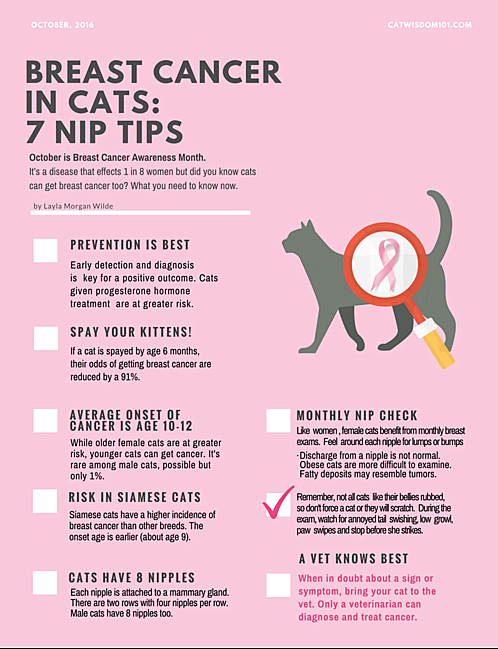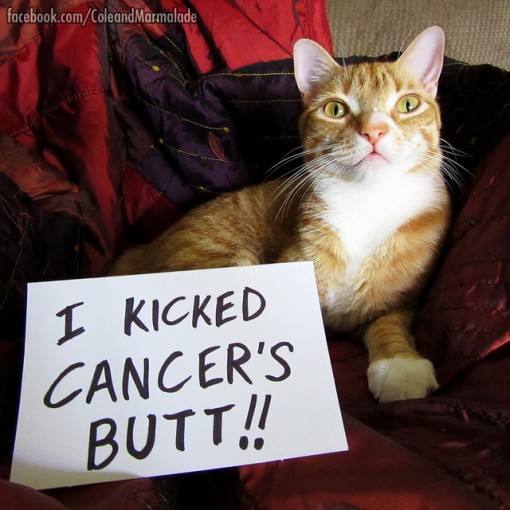
Cancer Clues in Cats
Cancer Clues in Cats By Layla Morgan Wilde
Updated: Oct.2020. October is Breast Cancer Awareness Month. See our post Cats Can Get Breast Cancer Too. May is National Pet Cancer Awareness Month and Feb. 4 is World Cancer Day. Six million pets in the U.S. will get the big “C” diagnosis this year. It’s a shocking statistic but the odds of surviving increase with early detection. There are so many clues to cancer in cats, it helps to be a detective to zero in on early signs.


We’re proud to be collaborating with our friends Cole and Marmalade on their video about cancer clues in cats. Be sure to view their video where their cat dad, Chris Poole plays detective for real! It’s cute and funny but cancer isn’t. Let’s spread the message of early detection and more happy cancer survivor stories like Marmalade’s.
Since this post was published Marmalade remains cancer-free but Cole was recently diagnosed with cancer.
Feline wellness is as much about preventing illness as treating it. The earlier we can detect illness, the easier it can be treated with better rates of healing success. For cat guardians, early detection means being observant of physical and behavioral changes on a daily basis. It means playing detective. While playing with, petting and grooming your cat, take a little more care to notice what’s different. The clues at first can be so subtle, partly because cats are hard-wired to hide symptoms of illness. It goes back to their wild roots when survival of the fittest was a matter of life or death.
We advocate for regular wellness vet visits at least once yearly. Geriatric cat require more frequent visits. The more clues or information you can provide your vet about your observations in a timely manner, the better.
These are the top seven clues for early cancer detection in cats. But remember, only a veterinarian can make a definitive diagnosis. Cancer is a leading cause of death in pets. It can be localized to one area i.e a tumor, spread or metastasize to other regions of the body. There are many types of cancer from skin, bone to breast cancer and lymphocarcoma caused by FeLV, the feline leukemia virus. While feline cancer tends to be diagnosed in older cats, younger cats can get cancer. Case in point: Marmalade (seen in photo above) was diagnosed last year at age two. He was successfully treated and is in remission.
1) Appetite and/or sudden weight loss.
Healthy cats have healthy appetites. They may be fussy but if they suddenly lose their appetite, something is amiss. It could be stress, dental issues or diseases. A cat who doesn’t eat at all for as little as three days is in danger of hepatic lipidosis. Gradual weight loss in older cats is common especially with kidney disease but sudden weight loss at any age is more a big red flag.
2) Lumps, bumps or wounds that won’t heal.
Many lumps, bumps and lesions heal on their own but when they don’t heal or lumps change, shape color or grow in size, it’s a cause for concern. Any discharge from a nipple or scaly red skin patches is a warning sign to call the vet. The best time to notice changes in the skin is during grooming or petting. Take care to examine longer-haired cats which can hide lumps and wounds more easily.
3) Abnormal smells.
Healthy cats smell good or at least not offensive. Bad odors emanating from the mouth, ears, uro-genital, anal or other area signal illness. Healthy cats have silky, shiny coats according to their breed standards. Greasy, smelly, rough or dry coats may mean it’s time for a bath. If a bath doesn’t help, it can signal a more serious issue. Note: if the litter box is unusually smelly, look for blood in the urine stools with or without diarrhea.
4) Vomiting.
All cats vomit on occasion from hairballs or mild digestive disturbance and is not a cause for alarm. However, if the vomit is bloody, chronic or heavy it can signal a serious illness including cancer.
5) Lethargy or difficulty moving.
If your cat’s get and go and got up and left or worse, he’s dragging his heels and limping, it’s time for a vet visit. A funky mood could be depression from any number of causes, but a lame cat means they are in pain. It’s up to a responsible guardian to determine is it a wound, abscess or a lump that might be a tumor.
6) Coughing or difficulty breathing.
If a cat is coughing more than once or twice a month, they may have asthma but the lungs are a favorite place for cancers to metastasize to. Any wheezing or difficulty breathing warrants prompt veterinary care.
7) Any unusual change in mood or behavior.
Cats love the comfort and security of routine meals, play and nap time. If your normally friendly and playful cat is fretful, hiding or lashing out or not using the litter box, there’s a reason. It may not be cancer but it’s good to know when something is wrong. With my cats, when any of them are ill, they hide in my dressing room closet. When any of them aren’t in their usual favorite places, I search around the house until I find them.
Cats are clever masters of hiding their symptoms. Don’t be fooled by your cat. Knowing your cats’ hiding places and early signs of illness isn’t just about playing detective but caring enough to see the whole picture, it just may save their life.






27 Comments
Pingback:
Bev Green
Great info..it pays to be aware indeed as most animals are masters at disguise..they have to be it stops the risk of predation..and our domestic kitties still revert to this behaviour..the first sign we had that oru sweet Merlin had FIV was an abscess that refused to heal..then his coat lost shine and his fur thinned..he still had a voracious appetite though and no physical illness as such..a very informative post indeed ! Fozziemum xx
Maggie
Happy Blogoversary, Layla and Kitties!
Thank you for another year of useful information, beautiful photographs, and Cat Wisdom.
xxoo
Layla Morgan Wilde
Thanks so much Maggie. I was singing your praises at Blogpaws.
Socks, Scylla, Fenris & Tuiren
Happy Blogoversary!!!!!!
Great information and we are so happy Marmalade kicked cancer’s butt.
Kjelle Bus aka Charlie Rascal
Excellent post and I´m sure glad Marmalade beat the evil “C” !
XOXO
Hannah and Lucy
Thanks for this information – Lucy is often sick but the vet said it’s because she eats too fast!
Luv Hannah and Lucy xx xx
Lauren Hughes
Question: My cat Shadow has been a tad skittish lately. Usually, she’ll let just about anyone pet her and rub her belly when she rolls onto her back, but lately she’s been running away from everyone except me. Is that something I should be worried about? I got her spayed and vaccinated back in September and she’s not due for her yearly shots until then. I thought maybe she was in heat but I’m not sure if spayed/neutered cats go into heat or not.
Layla Morgan Wilde
I’m not a vet but spayed cats do not go into heat. There is could be any number of resons for her skittishness and she is still a kitten. Try more interactive play with her and if still concerned, consult your vet.
Socks, Scylla, Fenris & Tuiren
You might want to talk to TBT at Marks Mews. He had to have one of his cats (Ayla) spayed several times. http://marksmews.blogspot.com/search?q=spay
Lily
That is so scary! Thanks for going over all that in this post. I’m so glad we are taking feline cancer awareness to the next level!
prancer pie
Wonderful, informative post!
Concats to Marmalade for kickin the big C!
meowmeowmans
Thanks for breaking it down for us, Layla. Catching cancer early really ups the chance of beating it. Hooray for Marmalade!
Judy & C.A.T.S.
Thank you for this important information. We recently found out that our beloved Cali has bone cancer in her back leg. She seemed healthy and then she suddenly started to limp. When we took her to the vet we expected that she had a minor problem. We were shocked and devastated when we saw the x rays. The vet said that the cancer is very aggressive. It came on very quickly. Love, Cali,Andy,Tater and Shelly (C.A.T.S.) and mom Judy
The Swiss Cats
Great informations ! Purrs
Brian Frum
Great info Layla on such a scary topic for all of us.
Skeeter And Izzy
Thank You! Thank You ! for this information. As with all of us early detection and treatment are key in beating so many diseases!!!!
We are so very, very happy that dear Marmalade is kicking cancer’s butt!!!! You go Boy!!
Luvs
Skeeter and Izzy and the Feral Gang + Twig & Peanut & Romeo >^..^<
Penelope
Very excellent post! Thanks for the most relevant information.
Kisses
Nellie
Annabelle
Excellent post and we are sure glad Marmalade beat the evil “C” butts!!!!
Sammy
Super information and VERY important to be alert for signs! Early detection saves lives.
Hugs, Sammy
The Island Cats
Good post! Thanks for sharing this all too important info. And we’re so glad Marmalade is doing so well now.
da tabbies o trout towne
thanx for sharin thiz post guys….N total lee rockin way sooper kewl news marmalade !!! ♥♥♥ YAY ~~~~~
Kathryn
Great news about Marmalade.
Thank you so much for all this great, great info!
Sometimes Cats Herd You
This is a pawesome list of things to be on the lookout for.
easy rider
Thanks for a super important post, I hope once we will find a cure and we all can kick this big evil C in the butt…
easy rider
Austin Towers
Thanks for this very important post!!
Summer
Great info – and paws up to Marmalade!